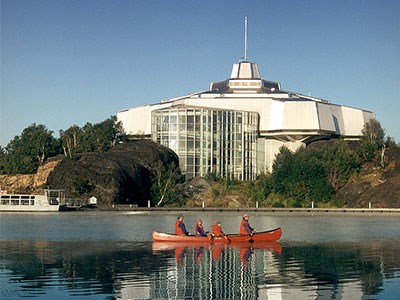Visitors to Science North in Sudbury can now see what the polar bears in Cochrane are up to while their counterparts at the Cochrane Polar Bear Habitat can simultaneously interact with scientists and bluecoats at the science centre. It’s part of an initiative that marks increased collaboration between Science North and other tourist attractions in Northern Ontario.
“We’re called Science North and not Science Sudbury, so that mandate to serve all of Northern Ontario and to partner with Northern Ontario is one we’ve always taken seriously,” said CEO Guy Labine, “but one I think we want to leverage on our experience and leverage on the opportunities that are made available thanks to the support of NOHFC (Northern Ontario Heritage Fund Corp.) and from others.”
The NOHFC recently gave $500,000 to the science centre to develop the project, along with its new travelling exhibit, Arctic Voices, on which Science North is partnering with the Canadian Museum of Nature. With 6,000 square feet of travelling exhibit space, the science centre is able to rent or develop new exhibits to encourage return trips.
“Travel exhibits have become important to Science North in renewing the visitor experience without it necessarily being permanent,” Labine said.
The relationship between the Sudbury and Cochrane attractions began in 2007. Science North has also partnered with the Canadian Bushplane Heritage Centre in Sault Ste. Marie on an aviation heritage project, and with the Red Lake Heritage Centre on a wildfires exhibit.
Labine said packages will be available that would allow visitors access to both Science North and the Cochrane Polar Bear Habitat. Cross-promotion to encourage increased tourism across communities ultimately benefits the North as a whole, Labine said.
“Many times a visit to Science North is a starting point for visits to other points in Northern Ontario, so the ability for us to be able to do packages with other attractions, I think, is something we want to be able to explore and to leverage,” he said.
Arctic Voices, the new travelling exhibit that examines the vegetation, wildlife, people and culture of the Arctic, is showing until September at Science North and will then open at the Canadian Museum of Nature in Ottawa. Arctic Voice is the 10th travelling exhibit Science North has developed.
Part of the exhibit was built by students studying carpentry and theatre arts at Collège Boréal. It gives students the hands-on opportunity to gain experience in their field of study, while increasing the expertise in exhibit development available in Northern Ontario, Labine said.
Because tourism is cyclical, it’s sometimes difficult to determine whether having a new exhibit would have contributed to either a decline or increase in attendance. Weather also plays a role. But there is a direct correlation between providing new experiences to visitors and their likelihood of visiting, Labine said.
When Science North brought in the Ripley’s Believe it or Not Exhibit last year, and its dinosaur exhibit a few years ago, attendance was up in both instances.
“Without our travelling exhibit portfolio of attractions, it would be difficult to think we could continue to attract a local (Northern Ontario) audience on a repeated basis,” he said.
In 2014, Science North is celebrating its 30th year in operation, while the Big Nickel—the precursor to Dynamic Earth—is celebrating its 50th anniversary.




